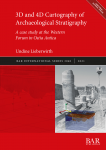3D and 4D Cartography of Archaeological Stratigraphy
A case study at the Western Forum in Ostia Antica - S3040
- Anno: 2021
- Autore/i: Undine Lieberwirth
- Catalogo: BAR British Archaeological Reports
- Argomento: Archeologia
- ISBN: 9781407357867
- ISSN:
This monograph focuses on one of the most interesting sections of the Main Forum of Ostia Antica, the ancient commercial port of Rome, during the 2nd-6th centuries AD. With a detailed 3D reconstruction of all collected information, it is possible to gain detailed insights into the development and destruction of the city centre during the transition from Antiquity to the Early Middle Ages. The applied 3D volume map in this study makes this possible by combining 2D, 2.5D and 3D solid objects inside a real geo-space. It completes the 3D space, generally filled with hollow objects, with content. With this work, Undine Lieberwirth gives archaeologists a free and open ready-to-use tool. The resulting space-time model of archaeological stratigraphy, geophysics and pedology opens new perspectives on 3D documentation and 3D analysis of archaeological and archaeology-related data. Her intention is not only to preserve archaeological excavation data in the best way possible but also to prepare them for future 3D and 4D analysis. The digital 3D cartography offers the perfect framework for this. To represent these 3D models appropriately, the usual 2D images in this monograph are replaced with 8 videos.
AUTHOR
Undine Lieberwirth studied Prehistoric and Classical Archaeology and specialised in Geographic Information Systems (GIS) with Geospatial Databases. Her scientific interests lie in researching efficient and sustainable applications of the Digital Humanities in Ancient Studies. A particular focus is on three-dimensional data acquisition, modelling and analysis. She has been experimenting with voxel depiction of archaeological stratigraphy in GIS since 2007.
REVIEWS
‘The 3D documentation of every layer in a single context excavation is highly unusual, having only been attempted a few times. Although the workflow is very complicated, this has the potential to be a visualisation/analytical game changer.’ Dr James Taylor, University of York
‘We are still at the beginning of true 3D-documentation of archaeological excavations. Recent advancement in technology is opening new possibilities for 3D-documentation of archaeological sites, and this work comes at a very good time. It will be of great interest for other researchers.’ Espen Uleberg, Museum of Cultural History, University of Oslo
F.to A4, 116 pages
ISBN:
BAR number:



